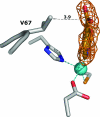Competitive inhibitors of the CphA metallo-beta-lactamase from Aeromonas hydrophila
- PMID: 17307979
- PMCID: PMC1891371
- DOI: 10.1128/AAC.00866-06
Competitive inhibitors of the CphA metallo-beta-lactamase from Aeromonas hydrophila
Abstract
Various inhibitors of metallo-beta-lactamases have been reported; however, none are effective for all subgroups. Those that have been found to inhibit the enzymes of subclass B2 (catalytically active with one zinc) either contain a thiol (and show less inhibition towards this subgroup than towards the dizinc members of B1 and B3) or are inactivators behaving as substrates for the dizinc family members. The present work reveals that certain pyridine carboxylates are competitive inhibitors of CphA, a subclass B2 enzyme. X-ray crystallographic analyses demonstrate that pyridine-2,4-dicarboxylic acid chelates the zinc ion in a bidentate manner within the active site. Salts of these compounds are already available and undergoing biomedical testing for various nonrelated purposes. Pyridine carboxylates appear to be useful templates for the development of more-complex, selective, nontoxic inhibitors of subclass B2 metallo-beta-lactamases.
Figures





Similar articles
-
The structure of the dizinc subclass B2 metallo-beta-lactamase CphA reveals that the second inhibitory zinc ion binds in the histidine site.Antimicrob Agents Chemother. 2009 Oct;53(10):4464-71. doi: 10.1128/AAC.00288-09. Epub 2009 Aug 3. Antimicrob Agents Chemother. 2009. PMID: 19651913 Free PMC article.
-
A metallo-beta-lactamase enzyme in action: crystal structures of the monozinc carbapenemase CphA and its complex with biapenem.J Mol Biol. 2005 Jan 28;345(4):785-95. doi: 10.1016/j.jmb.2004.10.070. J Mol Biol. 2005. PMID: 15588826
-
Sensitivity of Aeromonas hydrophila carbapenemase to delta3-cephems: comparative study with other metallo-beta-lactamases.Antimicrob Agents Chemother. 1997 Apr;41(4):866-8. doi: 10.1128/AAC.41.4.866. Antimicrob Agents Chemother. 1997. PMID: 9087509 Free PMC article.
-
Metallo-beta-lactamases (classification, activity, genetic organization, structure, zinc coordination) and their superfamily.Biochem Pharmacol. 2007 Dec 15;74(12):1686-701. doi: 10.1016/j.bcp.2007.05.021. Epub 2007 Jun 2. Biochem Pharmacol. 2007. PMID: 17597585 Review.
-
Class B beta-lactamases: the importance of being metallic.Curr Pharm Des. 1999 Nov;5(11):915-27. Curr Pharm Des. 1999. PMID: 10539996 Review.
Cited by
-
SAR Studies Leading to the Identification of a Novel Series of Metallo-β-lactamase Inhibitors for the Treatment of Carbapenem-Resistant Enterobacteriaceae Infections That Display Efficacy in an Animal Infection Model.ACS Infect Dis. 2019 Jan 11;5(1):131-140. doi: 10.1021/acsinfecdis.8b00246. Epub 2018 Nov 30. ACS Infect Dis. 2019. PMID: 30427656 Free PMC article.
-
Three decades of beta-lactamase inhibitors.Clin Microbiol Rev. 2010 Jan;23(1):160-201. doi: 10.1128/CMR.00037-09. Clin Microbiol Rev. 2010. PMID: 20065329 Free PMC article. Review.
-
Discovery of a Novel Metallo-β-Lactamase Inhibitor That Potentiates Meropenem Activity against Carbapenem-Resistant Enterobacteriaceae.Antimicrob Agents Chemother. 2018 Apr 26;62(5):e00074-18. doi: 10.1128/AAC.00074-18. Print 2018 May. Antimicrob Agents Chemother. 2018. PMID: 29530861 Free PMC article.
-
Clinical Features, Genome Epidemiology, and Antimicrobial Resistance Profiles of Aeromonas spp. Causing Human Infections: A Multicenter Prospective Cohort Study.Open Forum Infect Dis. 2023 Nov 16;10(12):ofad587. doi: 10.1093/ofid/ofad587. eCollection 2023 Dec. Open Forum Infect Dis. 2023. PMID: 38156048 Free PMC article.
-
Current challenges in antimicrobial chemotherapy: focus on ß-lactamase inhibition.Drugs. 2010 Apr 16;70(6):651-79. doi: 10.2165/11318430-000000000-00000. Drugs. 2010. PMID: 20394454 Review.
References
-
- Ambler, R. P. 1980. The structure of β-lactamases. Philos. Trans. R. Soc. Lond. B 289:321-331. - PubMed
-
- Bebrone, C., C. Anne, K. De Vriendt, B. Devreese, G. M. Rossolini, J. van Beeumen, J. M. Frere, and M. Galleni. 2005. Dramatic broadening of the substrate profile of the Aeromonas hydrophila CphA metallo-β-lactamase by site-directed mutagenesis. J. Biol. Chem. 280:28195-28202. - PubMed
-
- Cantor, C. R., and P. R. Schimmel. 1980. Biophysical chemistry. Part III: the behavior of biological macromolecules. W. H. Freeman and Company, New York, NY.
Publication types
MeSH terms
Substances
Associated data
- Actions
LinkOut - more resources
Full Text Sources
Chemical Information
Molecular Biology Databases

